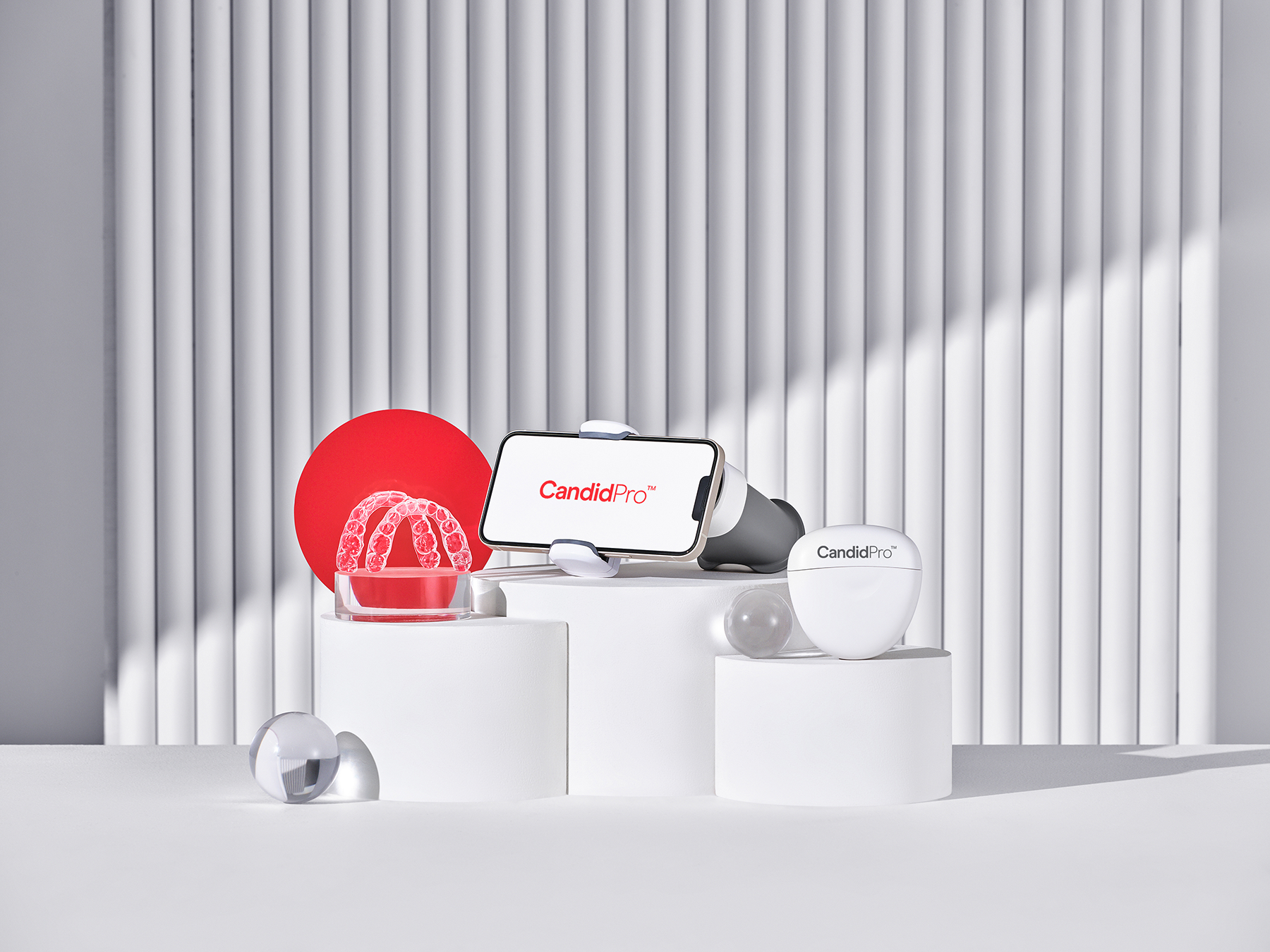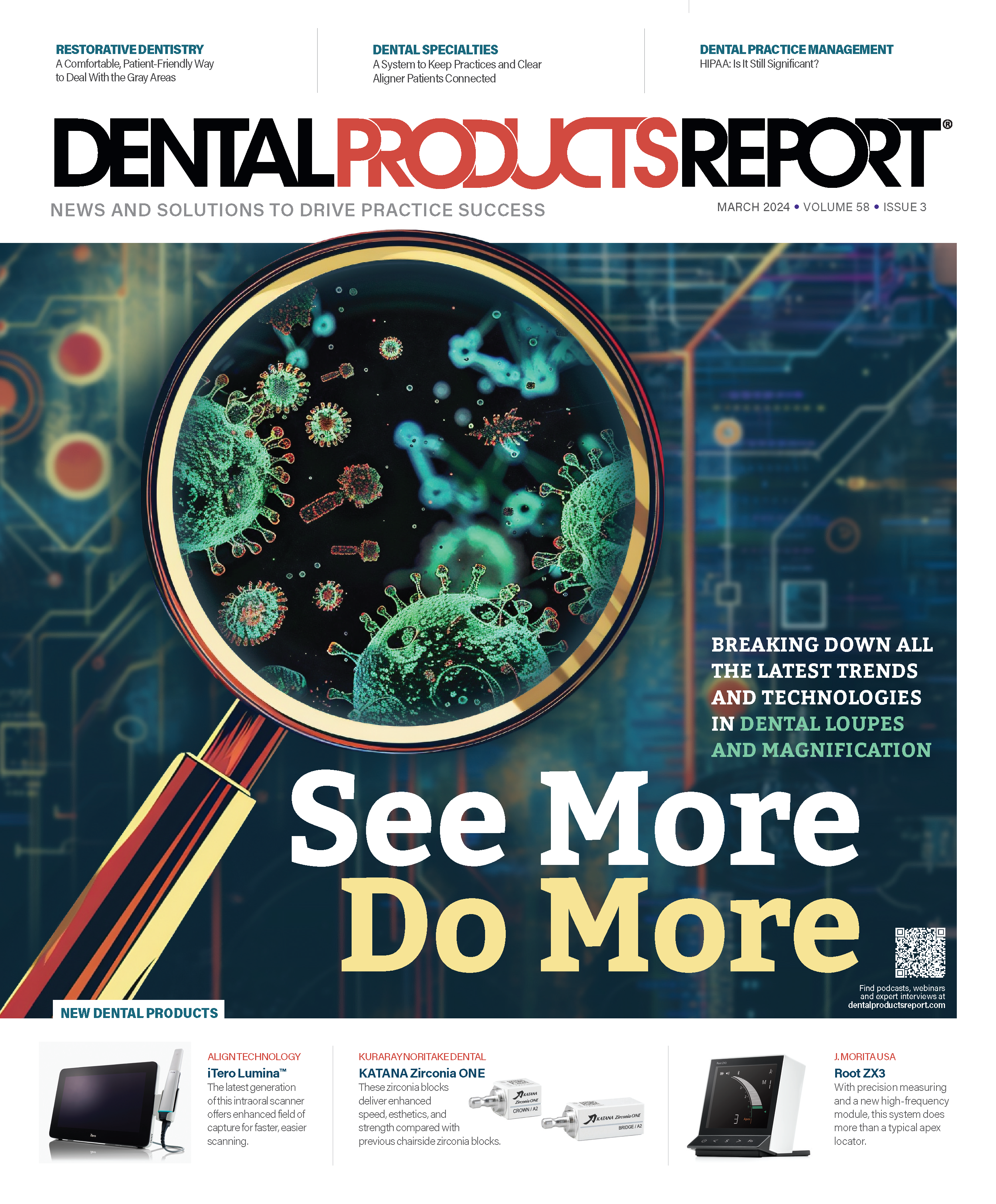I love efficiency. But actually, I love technology more, because with the use of technology, efficiency follows. For many years we have been experiencing technology-related efficiency gains through the data aspects of our treatments. By that I mean digital charting (including periodontal charting), digital radiography, digital photos (intraoral and extraoral), and more.
CandidPro
CandidPro offers an enhanced set of clinical features to give doctors more flexibility and control over clear aligner cases. The artificial intelligence-powered case design software can incorporate interproximal reduction, attachments, bite ramps, and other customizable preferences into their treatment plans. The aligners are fabricated from Zendura FLX materials that are clear and stain-resistant. Every case includes CandidMonitoring™ to keep cases on track.
Candid
844-295-6915
candidpro.com
Now we are seeing more of this efficiency extend to aspects of our practices that impact things outside the arena of data gathering and hands-on treatment. Sure, we all want to make appointments shorter for our patients while delivering outstanding care. However, how about making orthodontics more effective and easier by applying technology to help with that? And even better, what if that technology went with the patient everywhere, including when they are not in your office?
Did that get your attention? Good, because when I learned about this, it grabbed mine too.
Technology is helping make dentistry more predictable every year. With today’s modern materials, equipment, and techniques, we can forecast with great accuracy the amount of time needed for most of our procedures. This is key to operating an efficient dental practice and delivering a “wow” patient experience. Efficiency in treatment means your “reception area” is exactly that—a place where the patients are greeted, then escorted to the treatment area—not a “waiting room” where they sit for 30 to 45 minutes because the office is running behind schedule every day. Those are things that, with careful planning, we can control.
Challenges
However, delivering clear aligner orthodontic treatment efficiently presents a few unique challenges that even the most experienced clinicians cannot control, namely adherence, complexity, and biology.
Orthodontic treatment involves the gradual movement of teeth into a more healthy, stable, and esthetic position. Simply put, this takes time. With clear aligners being a removable appliance, it is hard to gauge in advance whether a patient will adhere to your daily aligner wear instructions. This is especially true when weeks or even months pass before you see them again. Scheduling “aligner check” visits every 12, 8, or even every 4 aligners can still allow for tracking issues to manifest, or relapse to occur, which often results in refinement.
All of us who provide clear aligner therapy have struggled with patients, normally younger ones, who feel that aligners are like homework—something to be done “if Mom is watching.” The patient comes in for a check and things have barely moved, if they have moved at all, or they are tracking in a way that will require corrective action.
Another variable that is hard to control for is complexity. Although a case may appear rather straightforward, and even on the lower end of the complexity spectrum, there are still some movements that are going to be more challenging to achieve with clear aligners. We know tipping is rather predictable, but even a small rotation planned and staged to occur between aligners 9 through 12 of a 22-aligner case adds complexity. Some manufacturers suggest that doctors should instruct patients to wear their aligners longer during these specific stages. From an execution standpoint this is nearly impossible to achieve with consistency. There must be a better way to control for complexity that meets adherence in the middle.
In recent years, research has shown that patients struggle with correct interval dosing on prescription medications, and some experts have even suggested moving to larger doses with twice-daily administration. If patients struggle to remember to take medications on a fixed interval, how successful will we be in expecting them to remember a variable schedule to wear aligners 9 to 12 for 2 weeks instead of 1? Not very successful, I would guess.
Then comes the most elusive element of all: biology. It is completely invisible and can change during treatment based on medications, hormones, and other factors.1-3 Every patient is unique, and their teeth can only move at the rate the bone remodels. We also know that nonsteroidal anti-inflammatory drugs (NSAIDS) such as aspirin, ibuprofen (Advil) and naproxen (Aleve) significantly slow the rate of bone remodeling and are readily available over the counter.4 Controlling for consumption of this variable is nearly impossible, as pain is a powerful motivator. These 3 variables are the cause of countless tracking issues, resulting in refinements, inefficient workflows, and a diminished patient experience.
As I have said in my columns many times, no one wants dentistry to take longer. There needs to be a way, a system that can provide a beautiful and esthetic result helping to minimize treatment time and discomfort. Anything that can decrease that treatment time will be welcomed by patients with open arms…and open mouths.
An Intelligent Solution
Fortunately, and finally, the clear aligner industry has caught up with clinician needs and assembled a solution. CandidPro clear aligners incorporated remote monitoring technology into the aligner system to address all these pitfalls without sacrificing the results that doctors and patients expect. It is called CandidMonitoring and it is included with every case, at no additional charge (Figure 1).
Artificial intelligence (AI) is making tremendous advances in dentistry, and now it is helping to make orthodontics easier. CandidMonitoring’s roots are deeply embedded in Dental Monitoring API, the French company that is home to the dental industry’s largest image database. It utilizes advanced remote monitoring technology powered by AI. Although it is an incredibly complex system on the back end in the cloud, it is easy to use and to explain to the patient. CandidMonitoring AI employs a multilayered neural network trained by real doctors to analyze specific pathologies with consistent digital precision. This allows for more frequent and accurate supervision of clear aligner cases, effortlessly advancing your clinical oversight to the next level from wherever the patient happens to be. I will go into more detail about the process, but for now imagine your patient using their phone camera and an app to let you see exactly where they are in the treatment process.
From the Doctor’s Perspective
A decent analogy (and I love a good analogy) may be to relate it to flying one of today’s advanced commercial aircraft. The pilot’s main job is getting the aircraft in the air and ensuring a comfortable and timely landing. Most of the flight is on autopilot with smart systems monitoring known and unknown variables and adjusting to them along the way to stay on course. Of course, the pilot is always truly in control and can at any time intervene and alter course. The pilot is the ultimate decision maker.
This is, in many ways, akin to how CandidMonitoring works. Once the doctor has approved the patient’s treatment plan, much of the work is already done. This plan includes the doctor’s prescribed protocol from takeoff to landing. In the event of a tracking issue, patients do not continue to blindly advance aligners, straying further off course. The system monitors the patient’s movements and alerts the patient and the doctor if the case is not tracking as anticipated.
Typically, the doctor has prescribed for the patient to remain in a holding pattern for 1 extra week. Patients must then check back for clearance to proceed to the next aligner by submitting a new scan to see whether they are back on course. If not, the cycle repeats again for 1 week. If the patient is still not on track, the doctor is notified, takes the controls, and manually instructs the patient on what to do next. In most instances this is a hands-on office visit to allow the doctor to fully assess the situation and prescribe the necessary corrections to get back on track (Figure 2).
Doctors can simply log into their CandidMonitoring portal and access their patients’ complete monitoring histories. These detailed records include high-resolution images and video showing tissues, teeth, and tracking at every aligner stage, with aligners inserted and out.
Fully informed with current clinical context, most often the patient is still instructed to continue to hold in their current aligner by their doctor and encouraged to be more adherent to aligner wear or counseled on other potential variables such as NSAID use. Thankfully, the patient has not continued to advance aligners through this challenging movement, as that can make it impossible to recover tracking without committing to a refinement. Even better, none of this required scheduling an appointment, appointment confirmation, room turnover, or a minute of chair time unless the doctor desires that.
For patients, things could not get much more intuitive. Every patient has become fluent with downloading an app, so installing CandidMonitoring takes just a couple of clicks. Today’s mobile phones use cameras with multiple lenses, incredible depth of field, stabilization technologies, and image postprocessing that allows them to upload intraoral images that are crisp, clear, and diagnostically accurate (Figures 3 & 4).
All patients are provided a compact and durable ScanBox pro device with their aligner kit at no cost. If they lose it, the company will send a replacement at no cost to the patient or practice. After completing 2 weeks in their current aligner, patients will be prompted on their phone to take and submit a scan that includes data on adherence, tracking, hygiene, and much more. This all takes just a few minutes with nothing more than their phone and the ScanBox pro attachment. It can be done from anywhere they are and will go directly to your portal, which you can access and respond to from anywhere you are. CandidMonitoring AI evaluates every image at every aligner stage for tracking and pathology. Based on your preferences, your patients will receive a notification to stay in their current aligner or advance to the next, based on how well their teeth are tracking to your prescribed treatment plan.
Utilizing a system like this makes sense. Instead of expecting each unique patient to adapt to a one-size-fits-all system, let the system dynamically adapt to each patient. That is exactly how our other clinical treatments and processes work.
We have seen some incredible advances in orthodontics in the past 2 decades. We have progressed from circumferential bands and ligature wires to bonded brackets and elastics to clear aligners that move the teeth gently and predictably. Now we are using the incredible advancements in AI to make another quantum leap forward. Considering so many practices offering clear aligner therapy struggle with efficiently completing cases, it may be one of your smartest decisions to evaluate this intelligent solution to see how it can benefit your practice. It has certainly made a positive impact on mine.
References
- Bartzela T, Türp JC, Motschall E, Maltha JC. Medication effects on the rate of orthodontic tooth movement: a systematic literature review. Am J Orthod Dentofacial Orthop. 2009;135(1):16-26. doi:10.1016/j.ajodo.2008.08.016
- Ong CK, Joseph BK, Waters MJ, Symons AL. Growth hormone receptor and IGF-I receptor immunoreactivity during orthodontic tooth movement in the prednisolone-treated rat. Angle Orthod. 2001;71(6):486-493. doi:10.1043/0003-3219(2001)071<0486:GHRAII<2.0.CO;2
- Krishnan V, Zahrowski J, Davidovitch Z. The effect of drugs, hormones, and diet on orthodontic tooth movement. In: Krishnan V, Kuijpers-Jagtman A, Davidovitch Z, eds. Biological Mechanisms of Tooth Movement (Third Edition). Wiley; 2021:199-215.
- Karthi M, Anbuslevan GJ, Senthilkumar KP, Tamizharsi S, Raja S, Prabhakar K. NSAIDs in orthodontic tooth movement. J Pharm Bioallied Sci. 2012;4(suppl 2):S304-S306. doi:10.4103/0975-7406.100280





